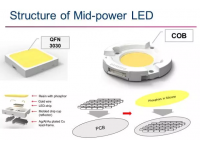
Due to its cost effectiveness, mid-power LEDs have been widely accepted as the energy efficient light source for general lighting. The catastrophicfails of mid-power LED (and COB) are dominated by gold wire breakage. Generally,the reliability is assessed by thermal shock test with Coffin-Manson-Model.This model has been widely used for failure-modes related to materials CTE(temperature expansion coefficient) mismatch. However, we are not sure if this approachis still good for the mid-power LED (and COB) gold-wire / silicone system. This is because the silicone material changes its state at around 25 degree C (socalled glass temperature). Below this T_glass, the silicone is at glass state,characterized by small CTE and very large modulus. Above, T_glass, the siliconeis in Gel state, having large CTE and small modulus. This change of propertieswill/does have large impact on the results/conclusion of our reliabilityassessmentimplyingpossible wrong prediction of catastrophic fail rates. With an extensive DOE, wepropose an improved Coffin-Manson model to cope with the Gel/Glass transitionduring experiment and applications.











An Improved Coffin-Manson Model for LED Wire-bonding
2017-10-18 张斌 可靠性与安规



